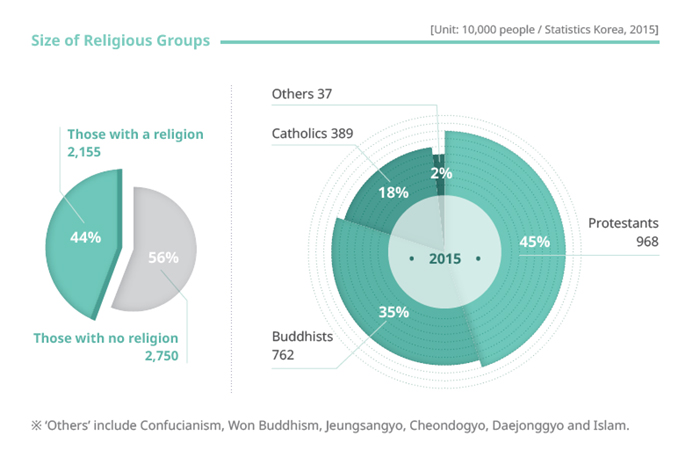Yes, it’s amazing how Christianity has been able to encroach in the previously called Hermit Kingdom.
Wikipedia has conflicting information.
In its article about Catholicism in Korea it says:
About 11% of the population of South Korea (roughly 5.8 million) are Catholics, with about 1,734 parishes and 5,360 priests as of 2017. By proportion of a national population and by raw number of adherents, South Korea ranks among the most strongly Catholic countries in Asia after the Philippines and East Timor.
South Korea’s flock saw the largest overall percentage increase in 2014, when it increased by 2.2%. Pope Francis visited the country in August of that year, the third visit by a pope to the country.
However, the article about Christianity in Korea tells a different story:
The practice of Christianity in Korea revolves around two of its largest branches, Protestantism and Catholicism, accounting for 8.6 million[1][2] and 5.3 million[3] members, respectively.
Which numbers are correct?
I went to korea.net and they had this to say:

The 2015 census had smaller numbers and the Protestants were way more than the Catholics as related by the following Wikipedia article:
Religion in South Korea is characterized by the fact that a majority of South Koreans (56.1%, as of the 2015 national census) have no formal affiliation with a religion. Protestantism represents (19.7%) of the total population, Buddhism (15.5%) and Catholicism (7.9%).
A 2016 article by the Diplomat says:
What can be most surprising to a visitor to Korea is that only 29 percent of the population actually identifies as Christian – about three-quarters Protestant, one quarter Catholic. But their zeal is so enormous that it overshadows the 23 percent who are Buddhist, and the 46 percent who say they have no religion at all.
“It is kind of amazing” how zealous Korean Christians are, says Dr. Hwang Moon-kyung, Professor of History at the University of Southern California. “They give you the impression that South Korea is a very religious country when in fact it isn’t. But the ones who are religious tend to be very fervently religious.”
Here is a more recent estimate (2018) from Vatican news (although the source may be a bit biased?)
The number of Catholics has increased by 48.6 per cent, from 3.9 million in 1999 to 5.8 million in 2018 and today they make up 11.1% of South Korea’s some 51 million population.
This said, yeah, we also wore lace kerchiefs in Italy at least until I was 15 (last time I ever had to do anything with religion and going to church). And that was in the '70s. An internet search informed me that since 1983 it is no more a requirement, although there may be some old ladies and some die-hard fanatics of old usage who still probably do. I do visit churches for tourism purposes, but I haven’t been checking the attire of the faithful too much.
Here is an article which cites the reason for the veil. It is infuriating. I felt my blood boil reading it. The most sexist and awful attitude. I thought the veil was cute, but now even if I were Christian I would never wear it. If you know Spanish you would be able to understand most of the Italian.
Here is an excerpt, for those who know the language:
d’ogni uomo il capo è Cristo, e che il capo della moglie è il marito, e il capo di Cristo è Dio. Qualunque uomo preghi o profetizzi avendo la testa coperta, disonora il suo capo; e qualunque donna preghi o profetizzi senza velo sulla testa, disonora il suo capo, poichè, se non si vela la donna, si tagli anche i capelli; e se è turpe per la donna il tagliarsi i capelli e radersi, si veli dunque. L’uomo no, non deve coprir di velo la testa, essendo immagine e gloria di Dio; e la donna è gloria dell’uomo. Poichè non viene l’uomo dalla donna, ma la donna dall’uomo, nè fu fatto l’uomo per la donna, ma la donna per l’uomo. Per questo deve la donna aver sulla testa il segno della sua dipendenza, per via degli angeli.


